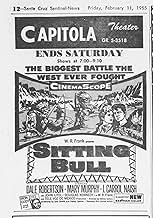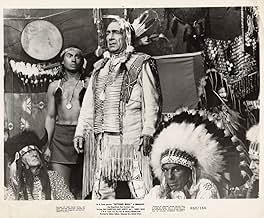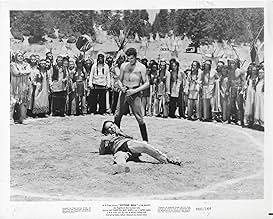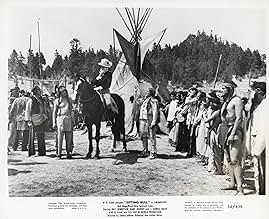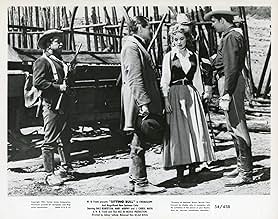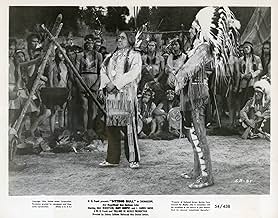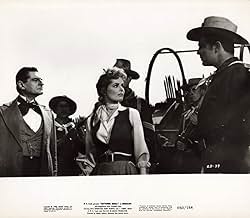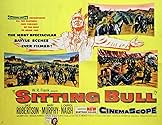Füge eine Handlung in deiner Sprache hinzuA cavalry officer sympathetic to the wronged Sioux fixes a meeting between Chief Sitting Bull and President Grant but a dishonest Indian Agent and a hateful General Custer test the Sioux's p... Alles lesenA cavalry officer sympathetic to the wronged Sioux fixes a meeting between Chief Sitting Bull and President Grant but a dishonest Indian Agent and a hateful General Custer test the Sioux's patience, threatening to derail the peace-talks.A cavalry officer sympathetic to the wronged Sioux fixes a meeting between Chief Sitting Bull and President Grant but a dishonest Indian Agent and a hateful General Custer test the Sioux's patience, threatening to derail the peace-talks.
- Regie
- Drehbuch
- Hauptbesetzung
- Charles Wentworth
- (as Bill Hopper)
- Webber - Indian Agent
- (as Tom Brown Henry)
- White Cloud
- (Nicht genannt)
- Trooper Foster
- (Nicht genannt)
- Young Buffalo
- (Nicht genannt)
- Trooper
- (Nicht genannt)
- Capt. Swain
- (Nicht genannt)
Empfohlene Bewertungen
J. Carrol Naish is Sitting Bull and Dale Robertson, the cavalry man who's on the side of the Indians. Its view of history may be a little off the wall but it's a perfectly accessible 'Cowboys & Indians' picture which makes you wish it were better written and acted; the on-again-off-again love affair between Robertson and Mary Murphy is frankly embarrassing. Not a great western, then and maybe not even a good western but as Dilys might say, not a bad one either.
But the "Bottom-Line" is that Most Movies are Made as Entertainment with a Profit Motive.
So Historical "Facts" Aside, as an Entertaining Piece of an Early Cinemascope Film (the first Independent) In the First-Half of the "Decade of the Western",
You Could Do Much Worse than this Nobly Intended Movie about the Sioux Chief "Sitting Bull",
His Constant Battles with "Forked-Tongue" Treaties and the General Inhumane Treatment of Prisoners,
Leading Up to the "Battle of Little Big-Horn" and Custer's Last Stand.
Playing Fast and Loose with some "Facts" is a Consideration to Make the Movie Box-Office Friendly.
But the Film Deserves Credit for Bucking the Trend of "White-Man Wins Called Victory...Indian Wins Called a Massacre" and Taking a Liberal Other-Sided Approach.
In the End it is Not Guilty of Over-Indulging the Re-Writing of History and Shows Respectable Behavior on Both Sides.
The Casting is Weak but the Story and the Epic Battles are Well Staged, Engaging, and Somewhat Informative.
All Things Considered...A Fine Film and Definitely...
Worth a Watch.
The story involves the efforts of the fictional Major Bob Parrish (Dale Robertson) and Sioux Chief Sitting Bull (J. Carroll Naish) to prevent a war between the Sioux nations and the U.S. Cavalry. On one side, Sitting Bull's chiefs led by Crazy Horse (Iron Eyes Cody) and Colonel Custer (Douglas Kennedy) on the other push their superiors into war.
The requisite love triangle involves Parrish, the General's daughter Kathy (Mary Murphy) and newspaperman Wentworth (william Hopper). Kathy turns away from Parrish when he is charged with insubordination and reduced in rank to Captain. She then becomes engaged to Wentworth.
Parrish meanwhile with the assistance of former black slave "Sam" (Joel Flueller)arranges a meeting between President U.S. Grant (John Hamilton) and Sitting Bull. However, before the meeting can take place several incidents occur and war breaks out culminating with Custer's last stand at the Little Big Horn.
J. Carroll Naish lends dignity to his portrayal of Sitting Bull. We see him as an intelligent caring and cautious leader who will stoop to war only as a last resort. In a move unusual for its time black actor Joel Flueller was cast in one of the leading roles in the film.
The battle scenes are spectacular and well staged by director Sidney Salkow. In spite of the contrived Hollywood ending, this western is a lot better than some would have you believe.
Enid: "This is so bad it's gone past good and back to bad again".
You could make a pretty good case that this silly little 1954 movie represents the bottoming out of Hollywood. There had been and would be worse movies, super-cheap independent productions and exploitation films by second tier studios, but it is unlikely that a top studio like United Artists has ever been associated with something quite this God-awful.
"Sitting Bull" was intended as a historical epic (or at least a modest budget example of one), another in a fast growing line of movies dealing with the Battle of Little Big Horn or Custer's Last Stand. What is amazing about Hollywood is their continued unwillingness to tell the straight story about the engagement, as the true events of this military action have generated a sustained interest for over 130 years. Like the James gang's raid on Northfield, Minnesota, the true story is far more interesting that any of the embellished movie versions. If Hollywood is going to distort the events then they should change the names and call it by its correct name, fiction.
I've seen most of these Hollywood efforts and "Sitting Bull" is pretty much in a class by itself in the distortion department. Curiously, it appears that a fair amount of historical research went into the production as recognizable names are bandied about throughout the movie but rarely are they linked to the individual's real actions. A relatively obscure officer like Miles Keogh, who was killed with Custer, is a character in the film but his rank is incorrect and he not present at the climatic battle.
Earlier comments point out the most absurd of the movie's inaccuracies and distortions. It is certainly sympathetic to the Indians as Hollywood was actually remarkably quick to adopt this attitude. But even here there are distortions as the film specifically shows the Chief ordering that brave dead troopers not be desecrated. In fact the Indians stripped the bodies and went into mutilation frenzy at the conclusion of the fighting.
Dramatically the film is flat with Dale Robertson wooden as the lead actor (too bad they didn't use Cliff Robertson instead). Mary Murphy ("The Wild Ones") is his love interest and Douglas Kennedy is Custer.
Indian sympathizer Major Bob Parrish (Robertson) sacrifices his Army career and his romance because of his Indian sympathies. He stands in the way of greedy prospectors who want the Indian Territory opened up so they can search for gold. This was actually to some degree Custer's position, but in the film Custer is portrayed as a rabid Indian hater. Custer was a rash glory-seeking cavalry officer, he attacked rather than wait for reinforcements because did not want to share the glory of a victory with Crook and Terry. While no friend of the plains Indian, he was at worst indifferent to them. His main fault lay in underestimating their will and ability to resist his relatively small command.
Murphy's relationship with Robertson is unintentionally hilarious and devoid of basic logic. So if you are forced to watch this thing, you can at least look forward to their scenes for some much needed (if unintentional) comic relief.
"Sitting Bull" doesn't limit its social conscience factor to the red man, Parrish finds time to free a runaway black slave Sam (Joel Fluellen) from prison. It turns out that Sam has lived with the Sioux and he takes Parrish to their camp for a peace conference. The mad dog Custer messes up his efforts by disobeying President Grant and attacking the Indians at Little Big Horn. Of course nothing like this actually happened. Nor did Custer find himself standing up in the middle of a flat piece of prairie as the Indians rode around and around his command like it was a wagon train in an early Hollywood western. How do you say pathetic in Sioux?
Than again, what do I know? I'm only a child.
This B film from MGM is yet another version of the events of surrounding the Little Big Horn battle where Douglas Kennedy as Custer got himself surrounded and massacred by some angry Sioux Indians. This version does show the Indian side of the events, how badly treated they were on reservations, how the whites once word of gold being discovered in their sacred Black Hills of Dakota territory systematically broke the treaties signed. Yet in fact the film went a bit overboard with presenting the Indian side and took great liberty with the facts.
Dale Robertson's an army major who zealously follows his orders about respecting the Indian rights, to the dismay of former General now Colonel George Armstrong Custer. Robertson's maverick tendencies wouldn't be liked in the army in any event, but his fiancé Mary Murphy who is General John Litel's daughter wants an upwardly mobile career man and Robertson doesn't look like a good bet. For standing on his beliefs Robertson loses her to newspaper reporter William Hopper.
But Dale gets himself in an even bigger jackpot. He's got an agreement with his former commander Ulysses S. Grant who is now president of the United States, the big chief of all the white folks. But when Custer moves prematurely and gets massacred and troops are sent on reprisal, Robertson does a very daring and potentially foolish thing to keep the peace process alive. That's the essence of our story.
Which of course never did happen. Neither did Ulysses S. Grant as played by John Hamilton on hiatus from the Superman series ever come west to negotiate with J. Carrol Naish as Sitting Bull. That's the biggest flaw in this film.
Murphy's character doesn't ring true either. From a woman who makes no bones about her desire for an upwardly mobile man, she does an about face and would make Tammy Wynette proud if Tammy had in fact ever seen Sitting Bull.
The film's heart is the in the right place, but the rest of it is out to lunch.
Though I will say one thing. If what I read is true about Mary Murphy's bout with Montezuma's revenge on location for this movie, she may have given one of the great performances of all time just getting through this film without a hint on screen.
Wusstest du schon
- WissenswertesThe film was shot outside of Mexico City, and star Mary Murphy caught "Montezuma's Revenge" and was very ill throughout the six-week shoot. Most of her scenes are relatively brief, possibly because of this.
- PatzerIn many of the scenes the women are obviously men.
- Zitate
Sitting Bull: I have wanted peace. I have prayed for peace. There have been battles. But when the white soldiers win a battle, they call it victory. When the Indians win, they call it massacre.
- Crazy CreditsDuring the opening titles, the film's 'Technical Advisor and Indian Costumes' is credited to 'Iron Eyes Cody' who is also parenthetically credited as being a '(Famous T.V. Star)'.
- VerbindungenFeatured in Entscheidung am Big Horn (1965)
- SoundtracksGreat Spirit
Music and Lyrics by Max Rich
Top-Auswahl
- How long is Sitting Bull?Powered by Alexa
Details
Box Office
- Bruttoertrag in den USA und Kanada
- 1.500.000 $
- Laufzeit
- 1 Std. 45 Min.(105 min)
- Sound-Mix
- Seitenverhältnis
- 2.55 : 1


